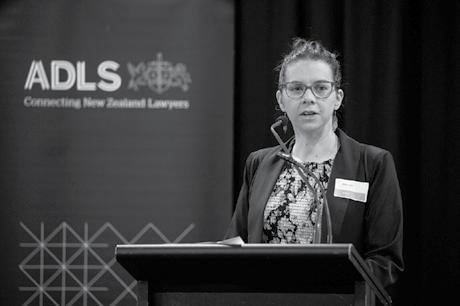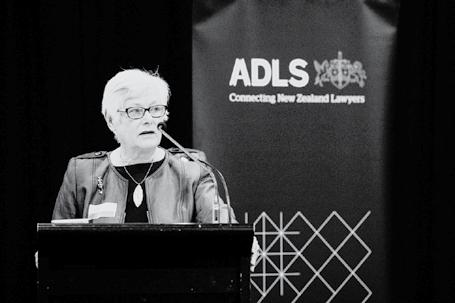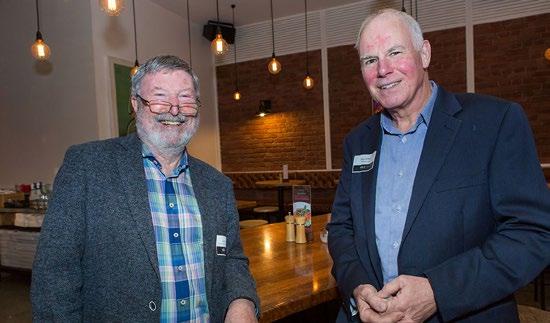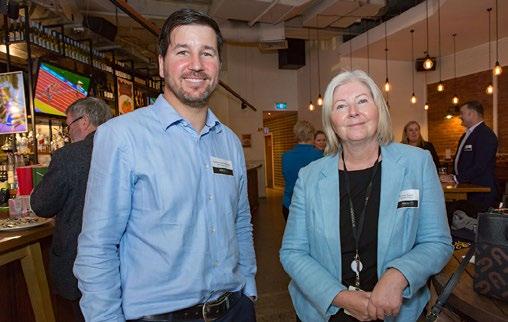
How plaintiffs can win a climate change


How plaintiffs can win a climate change
LawNews is an official publication of Auckland District Law Society Inc. (ADLS).
Editor: Jenni McManus
Publisher: ADLS

Editorial and contributor enquiries to: Jenni McManus 021 971 598 Jenni.Mcmanus@adls.org.nz
Reweti Kohere 09 306 3997 Reweti.Kohere@adls.org.nz
Advertising enquiries to: Darrell Denney 021 936 858 Darrell.Denney@adls.org.nz
All mail to: ADLS, Level 4, Chancery Chambers, 2 Chancery Street, Auckland 1010 PO Box 58, Shortland Street DX CP24001, Auckland 1140, adls.org.nz
LawNews is published weekly (with the exception of a small period over the Christmas holiday break) and is available free of charge to members of ADLS, and available by subscription to non-members for $140 (plus GST) per year. To subscribe, please email reception@adls.org.nz.
©COPYRIGHT and DISCLAIMER Material from this publication must not be reproduced in whole or part without permission. The views and opinions expressed in this publication are those of the authors and, unless stated, may not reflect the opinions or views of ADLS or its members. Responsibility for such views and for the correctness of the information within their articles lies with the authors.
Cover: Bloomberg Creative / Getty Images
Lawyers contemplating climate change litigation are being urged to use every tool at their disposal – including legislation and common law actions – to hold polluters to account.
So far, New Zealand’s courts have appeared reluctant to let climate litigation advance to trial through common law torts such as public nuisance and negligence. The wins have been rare, meaning many would-be litigants have been deterred by the prospect of protracted courtroom battles against betterresourced opponents.
But Dr Chris McGrath, a Queensland barrister practising in environment law, says a keep-it-simple approach could lead to more regular success.
With the Supreme Court yet to deliver judgment in the most significant climate change proceeding at present, Smith v Fonterra & Ors, there are plenty of openings to take strategic court action, he told New Zealand lawyers attending an online workshop hosted by the climate justice committee of the Commonwealth Lawyers Association.
“Litigation can be thought of as ‘strategic’ when it aims to
achieve a wider beneficial outcome than merely the remedy sought from the court. Of course, the proceedings must have merit and be legitimate in their own right – not an abuse of process. The wider purpose must be in addition to the underlying legitimacy of the proceedings.”
Climate change liability is widespread but largely unrealised, says McGrath, who has spent the past two decades working in climate change litigation. And as climate change litigation continues to increase, there will be more opportunities in Commonwealth countries to hold polluters to account for the extensive harm they have caused and will continue to cause.
One of the wider purposes of climate litigation is to address the impacts of human-induced climate change either directly or indirectly. Governments have been the initial targets, with complaints mostly based on alleged failures to do enough to meet their domestic and international commitments. Private
Continued on page 04

Lawyers should ground any potential litigation in real and specific case studies, rather than leaning on abstract theories and hypotheticals
Narrowing and avoiding disputes through negotiation and compromise are important and we should always pursue them where possible. But sometimes we need to fight, and we need courage and tenacity to do thisPhoto: Michael Hall / Getty Images
Continued from page 03
companies have more recently appeared in the cross hairs.
McGrath says common law causes of action and modern environmental and human rights laws may appear wide enough to meet the challenge. But lawyers should not assume this is the case.
“If they do not address climate change – a well-known, major threat facing human society and the environment, which will cause huge loss of life and property – there is something seriously wrong with them. Billions of people and trillions of dollars of property are already being impacted by climate change and these impacts will increase dramatically in the future.”
Lawyers should ground any potential litigation in real and specific case studies, rather than leaning on abstract theories and hypotheticals. And other perspectives should be considered: judges hearing such cases will be “smart lawyers without a background in climate science”, while opposing lawyers will most likely seek to muddy the court’s understanding and play procedural tricks to strike out any case before it gets to trial, McGrath says.
“Narrowing and avoiding disputes through negotiation and compromise are important and we should always pursue them where possible. But sometimes we need to fight, and we need courage and tenacity to do this.”
Webinar attendees explored McGrath’s framework of 10 issues – canvassing potential parties, best causes of action, available remedies, likely procedural obstacles and ways to “avoid being overwhelmed by a big opponent” – with reference to a potential damages claim by customary landowners in Papua New Guinea (PNG) against what the barrister claims is Australia’s largest direct climate polluter.
Located 160km east of Melbourne in the Latrobe Valley, the Loy Yang A Power Station sits next to an open-cut mine that fuels it with brown coal. The pair are Australia’s largest single source of direct scope 1 greenhouse gas emissions, averaging 18.5 MtCo2-e each year for a decade from 2012, McGrath says.. Their operator, AGL Loy Yang Pty Ltd, is a wholly owned subsidiary of energy company AGL Group. While it is possible to sue the parent, “for simplicity” the better focus would be the subsidiary, he says.
Using data for 2016, AGL Loy Yang’s direct emissions make up 0.05% of global emissions. While China’s emissions are 30%, the operator’s emissions would make it the 87th largest greenhouse gas polluter in the world if it were a country. Its emissions are larger than the annual emissions of more than 100 countries, twice the national emissions of PNG and more
than 10 times those of Fiji.
“It is a simple, compelling argument to say to a judge in PNG: ‘This single company has emissions twice the entire nation of PNG. Its emissions are greater than 100 nations. Clearly, its emissions are a material contribution to climate change’,” McGrath says.
While international law cannot compel payment for loss and damage arising in a dispute between nations, lawyers could turn to a range of causes of action, including transnational liability.
Transnational climate litigation, where legal liability spans two or more domestic legal systems, is a relatively new frontier, but McGrath says its potential is immense as it can form the basis for a claim in one country against large corporate polluters in other countries. These claims are strategic because they can empower people and communities suffering from climate damage to take action in their own national courts, thereby providing access to justice.
But the law is not well-developed in New Zealand. In Smith v Fonterra & Ors, climate change activist and Iwi Chairs Forum spokesperson Michael Smith in 2020 sued seven New Zealand companies – including dairy conglomerate Fonterra and petrol retailer Z Energy – he perceived as high-emitters. Smith claimed the defendants’ actions constituted public nuisance, negligence and breach of a duty to cease contributing to climate change.
Justice Edwin Wylie threw out the first two claims but declined to strike out the third. While Smith faced “significant hurdles” in his bid to persuade the court that the duty of ceasing to contribute to climate change should for the first time be recognised, the High Court judge held that the relevant issues should be explored at trial.

The Court of Appeal in October 2021 upheld the struck-out claims and removed the novel duty cause of action, saying that tort law was not the appropriate vehicle for dealing with climate change as “every person in New Zealand – indeed, in the world – is (to varying degrees) both responsible for causing the relevant harm and the victim of that harm”.
Having granted leave to appeal in March 2022, the Supreme Court heard the case in August last year.
MinterEllisonRuddWatts, which represented two of the Smith defendants, explains that common law torts traditionally require a proven causal link between a defendant’s actions and the harm suffered by the plaintiff.
“Climate change is notoriously challenging in this respect:
Continued on page 05
Common law causes of action and modern environmental and human rights laws may appear wide enough to meet the challengeDr Chris McGrath
Continued from page 04

everyone contributes to climate change, and everyone is also a victim of it, in each case to a greater or lesser extent,” Minters says. “In the context of a global climate system in which the effects of human conduct are complex and occur over generations, how can there be any realistic prospect of proving that the actions of one enterprise contributing an infinitesimally small proportion of global emissions have any effect upon a single plaintiff?”
McGrath says establishing causation starts with common sense. In the workshop example, AGL Loy Yang’s direct emissions are entering the Earth’s single atmosphere, which affects everyone, including the Carteret Island landowners. However, as the law requires a more rigorous test, a throughline in common law jurisdictions is that two or more acts which combine to cause the harm are legally causative if they materially contribute to the loss suffered.
Lawyers can best frame material contribution around a defendant company’s annual emissions compared to the national emissions of the country hearing the claim, along
with the carbon budget, a tool that quantifies the cumulative amount of carbon dioxide that can be emitted into the atmosphere by human activities to hold the rise in mean global temperatures to typically less than 2 degrees Celsius to 1.5 degrees Celsius above pre-industrial levels.

McGrath says while there is ongoing debate and refinement of the concept, it is widely adopted and gives a “simple and strong” basis for establishing causation, while countering arguments that an individual project’s emissions are too trivial to concern the law.
While not directly addressing the Smith litigation, McGrath cautions against a multi-defendant suit as lawyers should limit any litigation to one corporation and one activity in a jurisdiction where judgment can be enforced. “Trying to sue multiple, large corporations or governments for multiple activities simultaneously multiplies the complexity exponentially,” he says. “You can simply be overwhelmed.”
Lawyers should lay out a pathway for the courts to follow and expect them to step up in the face of destruction. “There are people dying already. Huge amounts of people will be displaced,” he says. “Dealing with this is essential.” ■
Smith claimed the defendants’ actions constituted public nuisance, negligence and breach of a duty to cease contributing to climate change
There can be no doubt that a government digital strategy requires a lead agency. But one must wonder at the scope of the remit which goes beyond establishing a functioning, robust and resilient infrastructure so citizens can easily do business with the government
David HarveyCoping with the challenges of the digital paradigm and the discourse it enables has exercised governments for some time.
Following the 2010 case of Police v Slater, where the notorious blogger Whaleoil was prosecuted for breaching suppression orders, the then-Minister of Justice Simon Power requested the Law Commission to undertake a review of what he described as the “wild west” of the internet
The Law Commission was tasked with examining the adequacy of regulations around how the internet interacted with the justice system. In particular, Power observed that bloggers and online publishers were not subject to any form of regulation or professional or ethical standards. He considered it imperative that the law kept pace with technology and there was one set of rules for all news media.
The Law Commission review produced an issues paper in December 2011, but its work was interrupted by a request by the then-Minister of Justice Judith Collins to expedite recommendations about the adequacy of sanctions and remedies available for harmful digital communications following a series of New Zealand Herald articles about cyberbullying.
The commission provided a ministerial briefing paper, Harmful Digital Communications: The Adequacy of the Current Sanctions and Remedies (August 2012), containing recommendations and a proposed Bill. The Harmful Digital Communications Act followed in 2015.
The Law Commission delivered its final report in 2013, The News Media Meets ‘New Media’: Rights, Responsibilities and Regulation in the Digital Age (NZLC R128, 2013). However, its recommendations were overtaken by events. Online news media publishers set up the Online Media Standards Authority which was subsequently folded into the Press Council which renamed itself the New Zealand Media Council.
The provisions of the Broadcasting Act 1989 and the establishment of the Broadcasting Standards Authority (BSA) remains, although the BSA issued a new code in 2022. There
were a few changes to the Films Videos and Publications Classification Act to address video streaming and take-down orders. And there, as far as regulatory frameworks were concerned, things remained.
In February 2019 the then-Minister for Internal Affairs and Broadcasting, Communications and Digital Media, Kris Faafoi, agreed to carry out a comprehensive reform of New Zealand’s media content regulation system.
This review was put on hold after the 15 March Christchurch massacre and the intervention of covid-19 meant this project was “reprioritised”. It was revived in February 2021 when a Cabinet briefing initiated a broad review of the content regulatory system which is being managed by the Department for Internal Affairs (DIA).
The rationale for this review and the subsequent papers and work is that the present regulatory system is no longer fit for purpose in the digital paradigm. Little or no discussion features in any of the papers to explain why this is so, or in what way the present system is failing. The Law Commission’s work on media regulation that resulted in the 2013 report does not rate a mention. Certainly, the business models of mainstream media are being significantly disrupted, but this does not mean existing regulatory systems are wanting.
That said, the way the Harmful Digital Communications Act (HDCA) operates has some shortcomings. The decision of the government of the day to abandon the idea of a dedicated communications tribunal that could swiftly deal with online harms was a mistake. The individualised nature of the complaints system and the exclusion of groups from the ambit of the legislation is also a shortcoming. These can be remedied by amendment.
Interestingly, in the papers that have emerged from the
Continued on page 07
Perhaps the focus should be directed towards unlawful online activity rather than making the environment ‘safe’
Continued from page 06
DIA there is little examination of the role of the HDCA in the overall content regulatory system. In the DIA’s discussion paper Safer Online Services and Media Platforms, which examines the options for a new content regulatory system based on industry codes for different types of platforms, the HDCA barely rates a mention. Yet the Act is a classic example of internet exceptionalism in that it provides remedies and creates offences specifically for harmful online behaviour.
The HDCA is administered by the Ministry of Justice. Critical to the operation of the legislation is the role of a statutory body – the Approved Agency. The role of the agency from the outset has been filled by the well-known NGO Netsafe. Funding for Netsafe’s role as Approved Agency has come from the Ministry of Justice. It also receives funding for its educational activities from the Ministry of Education.
Importantly, there is a distance between Netsafe and government involvement in this area. From the point of view of optics, it would be seen as government interference in moderating communications if government agencies were directly involved. That could have implications for the freedom of expression guaranteed by the New Zealand Bill of Rights Act 1990. This was recognised some years back when there was a possibility the DIA might bid for the role of Approved Agency. That initiative was quietly dropped.
That said, there is a view that the DIA has a role to play in the online safety space. Six percent of respondents to a survey suggested they would report harmful content to the DIA. And as I have suggested, the DIA is leading the review into online content regulation.
While the consultation period for the Safer Online Services discussion paper was still open, there were other moves in the online space that suggest a consolidation of governance functions. That this should have taken place while a public consultation on content regulation was in train is curious, to say the least. That it should take place within weeks of a general election could suggest a desire by the government to set things in place while it still could.
The first inkling that something was going on was the announcement in July that CERT NZ – the Computer Emergency Response Team – would become part of the Government Communications Security Bureau’s (GCSB) National Cyber Security Centre. Cabinet papers released on 15 August (and which are not easy to find but are here) under the anodyne title Digital Service Transformation: Building modern, integrated and resilient digital public services explain the proposal in this way
There is an opportunity to make the Government Communications Security Bureau (GCSB) the lead agency for cyber security by expanding its role to have responsibility for cyber security operations. This will require integration of Computer Emergency Response Team (CERT NZ) into the GCSB. This would also be supported
by the recently strengthened mandate for the Government Chief Information Security Officer role held by GCSB [ERS23-MIN-0016].
No rationale for this move is advanced in the documentation. No consultation preceded the decision. Concerns were expressed that placing an outward-facing non-intelligence organisation under the umbrella of an intelligence agency could create conflicts of interest and compromise the independence and transparency necessary for effective cybersecurity operations. The transfer will be implemented by 1 October 2023.
A further development that appears in the same paper is the disestablishment of the Digital Executive Board established in 2022 as an interdepartmental executive board under the Public Service Act 2020. The board aims to provide a dedicated forum for stronger and more enduring coordination and alignment of the government’s digital program. However, despite the efforts of the board to support cross-agency initiatives in the digital area, its current remit and functions were not considered broad enough to drive and lead a whole-of-system approach to transform digital public services. Accordingly, the proposal advanced is that the government’s digital strategy will no longer be led by the board and will instead be led by a more “informal grouping” of the relevant chief executives. The new remit will be the DIA (Government Chief Digital Officer and Chief Privacy Officer); the GCSB (Government Chief Information Security Officer); the Public Service Commission (Head of Service), Statistics New Zealand (Government Chief Data Steward) and the Inland Revenue Department (System Lead Service Transformation).
The role of the DIA is important. The servicing department for the grouping will remain as the DIA which, in the words of the papers, “will continue to provide light-touch secretariat support to the board, with further support provided by officials from member agencies (eg, in the form of working groups). The DIA will also continue to administer the appropriation from which the board is funded.” Thus, the DIA will control both the agenda and the funding.
The final development of note – and of concern – involves Netsafe, the Approved Agency under the HDCA. As I have observed, Netsafe fulfils two roles – the Approved Agency for which it is funded through the Ministry of Justice and an educational and civic responsibility role for which it receives funding from the Ministry of Education.
The Cabinet Paper observes, however, that the DIA leads the government’s work on digital safety and online harm, working with agencies such as the police to respond to and support those affected by cybercrime which was the role of CERTNZ.
Netsafe is seen as a part of the online safety system. Without any consultation or discussion with either Netsafe or its two
Continued on page 08
The decision of the government of the day to abandon the idea of a dedicated communications tribunal that could swiftly deal with online harms was a mistake
About Corcoran French
We walk the talk in caring for our people. Corcoran French is well-known for having an enviable workplace culture – we work hard on this, and we don’t take it for granted. You’ll find that we’re supportive, progressive, flexible and an all-round pretty great bunch of people. Our partners are approachable, inclusive and are focused on ensuring each person is supported, achieves their goals and reaches their potential. In short, at Corcoran French, you really matter.
He angitūtanga | The opportunity
Are you looking to make the move to Christchurch? Give us a call! We’re seeking a senior lawyer who has excellent technical relationship property experience to help lead our family team. Our successful and tight-knit family team works across a broad range of family law work including contracting out agreements, separations, dissolution, family violence, adoption, care of children and protection of property rights.
He kōrero mōu | About you
You’ll be a capable and skilled solicitor with at least eight years’ family law experience, with a focus on relationship property matters as well as private client childcare, domestic violence and PPPR court work. You’ll enjoy mentoring others and sharing your expertise to help those around you thrive.
Equally important is your alignment with the values that are at the heart of Corcoran French.
Continued from page 07
funding agencies, the Cabinet paper stated:
There is also an opportunity to consolidate and clarify the management of the government’s relationship with NetSafe. To better ensure alignment of the government’s security and social cohesion priorities, and to strengthen our relationship going forward, we propose consolidating NetSafe funding arrangements in the Department of Internal Affairs, consistent with DIA’s role in digital safety and online harm.
Moving the contractual relationship to the DIA raises questions such as whether there are greater plans afoot to consolidate the online safety regulatory ecosystem within the DIA, whether there are plans to change the role of the Approved Agency or to amend the HDCA and whether there might be any potential conflicts of interest in DIA’s role in the wider online safety ecosystem.
This change and its potential effects was not signaled in the consultation paper and significant questions therefore arise as to whether this is a genuine open-minded consultation or whether certain decisions have been made behind closed doors and on which the New Zealand public and affected parties have had no input.
Certainly, the three initiatives I have described suggest a centralisation of control over the government’s digital agenda. What must be of concern is the unilateral way in which these decisions were made. Although there has been a consultation process in place regarding safer online services, these significant governance steps were taken in the background with little or no fanfare until there was a fait accompli
The decisions seem to have been taken unilaterally. There was no public consultation relating to any of them. The evidence so far allows one to consider whether an inference can be drawn that the DIA – the department in charge of the censorship regime under the Films Videos and Publications Classification Act – wishes to widen its control over digital content that may be less harmful than “objectionable content” under that Act.
There can be no doubt that a government digital strategy requires a lead agency. But one must wonder at the scope of the remit which goes beyond establishing a functioning, robust and resilient infrastructure so citizens can easily do business with the government.
Nōu te rourou | What’s in it for you
• Leadership and possibility of progression to partnership for the right candidate
• Contribution towards relocation costs
• Varied and interesting opportunities from day one
• Competitive remuneration
• Excellent professional development opportunities
• Strong commitment to work/life balance, and a well-used flexible working policy
• Day off for your birthday, and a host of other wellbeing initiatives including an active social club
Find out more about life at Corcoran French on our website: https://cflaw.co.nz/careers/

Tēnā tonoa mai | How to apply
For further information or to apply, please contact our HR Manager, Jo Yusaf jo@cflaw.co.nz or 03 371 1030. All conversations and applications will be treated confidentially. No agents please.
That scope strays into the area of “online safety” which may encompass a range of concerns from “I’m offended by that content” to “I’ve been defrauded of half a million dollars”. Perhaps the focus should be directed towards unlawful online activity rather than making the environment “safe.”
Inevitably, one is drawn to the start of this whole process back in 2019 where what was proposed was a review of regulating content. Content for most internet users involves what they can acquire via online e-commerce sites, sending messages and photos via any one of a number of platforms or engaging in one of a number of social media sites. At times the discussions will be robust and even confrontational. But I wonder whether citizens would like the idea of the DIA or the GCSB snooping on their online activity. The implications for democratic rights and freedoms and especially the freedom of expression could be considerable.
Some form of explanation for what is going on should be forthcoming. In making that explanation, the official or department in question should acquaint themselves with the provisions of the Plain Language Act 2022, something which seems to have been lacking in the Cabinet papers. ■
David Harvey is a retired District Court Judge. He is now a barrister at Sangro Chambers ■
This will give delinquent landlords a reason to improve their behaviour or regulated property management will be forced on them. It will help get rid of the cowboys and make it difficult for them to carry on treating tenants badly
Another layer of enforcement will be added to the Tenancy Tribunal’s arsenal against bad landlords under a new section in the Residential Tenancies Act.
Section 109AA will empower the Tenancy Tribunal, in a limited range of circumstances, to order a landlord to use the services of a licensed residential property manager in any subsequent tenancies if he or she has committed two or more unlawful acts within the past five years in cases decided by the tribunal or District Court.
Unlawful acts by landlords include leaving a rental in a filthy state, not maintaining the property or addressing repairs, not having the required smoke alarms, issues around contaminated premises and issuing retaliatory termination notices or terminating tenancies without grounds.
Unlawful acts listed in the bill do not include honest mistakes by landlords, such as missing dates
on paperwork.
The proposed change has surprised the Property Investors’ Federation. Vice-president Peter Lewis says he can see the philosophy behind it, but the federation believes making a landlord use a property manager for two transgressions in five years is punitive and not effective.
“We think it should be enforced if a landlord commits two unlawful acts within 12 months. It would sort out the really bad landlords.”
Lewis says the federation doesn’t think the proposed new clause is necessary. “Quite draconian penalties of up to $6,000 already exist for landlords who do the wrong thing and act badly.”
He says a landlord can inadvertently transgress twice in five years. “They are usually not intentionally doing the wrong thing, but may have just slipped up in attending to paperwork, for example.”
However, Residential Property Managers Association (RPMA) council member Ryan Weir says
having a long rolling period between transgressions means if landlords carried out an unlawful act three or four years previously, it will come back to haunt them if they make another mistake.
Weir says good landlords feel they are tarnished by recidivist bad landlords. “This will give delinquent landlords a reason to improve their behaviour or regulated property management will be forced on them. It will help get rid of the cowboys and make it difficult for them to carry on treating tenants badly.”
The proposed new clause exempts Kāinga Ora and registered community housing providers from the penalty.
Lewis is disappointed. “Kāinga Ora has a bad reputation for managing tenants who cause problems in its complexes and also for home owners in the vicinity. It seems inequitable that it is exempt. We have many horror stories about bad management from Kāinga Ora. The government frequently makes changes to the country’s laws but exempts its own departments from having to obey them.”
He says the original Residential Tenancies Act 1986 included what was then Housing New Zealand. Since then, changes to the Act have exempted Kāinga Ora. ■
NEW EDITION

Authors Stephen Todd, Cynthia Hawes, Ursula Cheer, Bill Atkin
Todd on Torts is the definitive tort work for law students and practitioners. It is the most frequently cited book in decisions of the New Zealand courts, a testament to its exemplary standards and authoritative reputation.
Major new or rewritten topics include:
■ the impact of tikanga Māori on the developing common law of torts
■ using proceedings in tort as a means of controlling global warming
■ the scope of the duty of care and the relationship between the duty issue and the cause of harm
■ liability issues arising from a biosecurity failure at New Zealand’s borders
■ the direct liability of parent companies for the torts of their subsidiaries
■ visual intrusion into property as constituting a nuisance
■ the ambit of the elements of vicarious liability
Price for ADLS members $235.80 plus GST*
Price for non-members $262 plus GST*
(* + Postage and packaging)
To purchase this book please click here or contact the ADLS bookstore by phone: 09 306 5740 or email: thestore@adls.org.nz
Nobody wants to cause undue stress to complainants in sexual offending cases. But why are complainants in these cases effectively regarded as being inherently more truthful than complainants in other cases, such that their evidence must be pre-recorded months or a year in advance?
Michael BottI recently received a call from the police. Someone had been arrested and charged with significant sexual offending. I felt the weight on my chest, knowing the enormous stress and long hours that lay ahead if I were to represent him - the pressure that would rest on my shoulders as he placed his future in my hands.
I went down to the cells at the station to see him. As he spoke, I realised I could not act. I was potentially conflicted as I might know a witness. I approached 12 other defence lawyers before finding one prepared to take the case on. The message was almost the same: "I have had enough of doing this. It is not worth it. I want my life back."
How the state views lawyers who undertake legal aid work is clear from the fact that legal aid rates have been effectively frozen for close on 15 years. There was a recent small incremental increase, but the gulf between what lawyers receive for private work compared with legal aid rates grows wider and wider. Successive governments have no interest in closing the gap.
Car mechanics are now billing their labour at between $100 and $140 an hour. Further, when they finish work it does not follow them home and keep them awake. The Crown solicitor’s terms of office sets a senior prosecutor’s rate at $260 an hour. The hourly rate for senior legal aid trial lawyers is $146 and up to $178 for serious cases. A principal Crown prosecutor’s pay rate is $309 per hour. There is no equivalent legal aid rate.
A senior Crown prosecutor’s rate is $260 an hour. The hourly rate for senior legal aid trial lawyers is $146 and up to $178 for serious cases
It is as if the state believes criminal trial lawyers' sense of professional obligation and social conscience mean they will keep some skin in the legal aid scheme. This view is corrosive of the wellbeing of practitioners, who have to work longer hours to meet the burgeoning demands of increased compliance, with recent rules and changes to trial process.
All lawyers recall the sensible remarks of English jurist Blackstone,"[B]etter that ten guilty persons escape than one innocent suffer.”
One of the most painful parts of a defence lawyer’s job is that despite doing your best in trial, the jury comes back and finds guilty a client you believe to be innocent. Imprisonment follows and a life is ruined. Lying awake, you wonder if you could have done something better.

Unconcerned about possibly innocent people being banged up for things they did not do, Parliament has made a concerted
Continued on page 11
Continued from page 10
effort to water down Blackstone’s sound caution, enacting laws that make it easier to convict people by shifting the goal posts.
The new rules in relation to fast-tracking pre-recorded evidence from complainants in sexual violence cases and the increasing burdens placed on defence lawyers, combined with the low rates of remuneration, mean senior lawyers are leaving criminal defence work.
I was reminded of this when attending a sexual violence legislation forum. A judge and an academic gave prepared talks about the changes and how they would help victims. Bullet points and graphs were displayed. But despite providing several questions during the forum about the impact upon fair trial rights, my questions went unanswered.
Parliament has foisted changes upon the criminal trial process with no understanding of their impacts on defendants (people presumed innocent). These changes will see criminal barristers who represent defendants in sexual violence cases doing significantly extra work.
Experienced practitioners told the select committee the proposals would be corrosive to fair trial rights. Still, it was as if the MPs were conducting open heart surgery on the failing body of justice, keeping their ears blocked and eyes shut as to the reality of how fair trial rights would be impacted. You can’t keep introducing extra processes with extra work for barristers without proper funding.
Starting with the loss of depositions, the delays from arrest to the laying of charges to the trial have ballooned and have become even worse post-covid. A person be charged today will have to wait well over a year before his or her case comes to trial.
To avoid the stress to complainants in sexual violence cases, their evidence must be pre-recorded, often a year in advance and very early in proceedings. While the case itself might be listed for

trial in a year’s time, the barrister will have to prepare to crossexamine the complainant at the outset and then, close to actual trial, review and sharpen the preparation again.
Another sign of the corrosive effects upon fair trial rights: complainants are now referred to as “victims” from the outset. Legally, the presumption of innocence means there is no victim until a court returns a verdict.

Worse, before recording the evidence, barristers must attend a ground-rules hearing and submit questions for the complainant to a judge, for vetting in advance. But at the start of a case, full disclosure is not available. Often, the Crown or police are providing disclosure – the evidence that informs the case - right up until the night before the trial gets underway.
Not only does the Crown – with its larger resources, such as staff, police and forensic evidence – face off against a defendant and a sole lawyer, but the defence must now flag its defence at the start of the process.

This gives the Crown, with its greater resources and rates of remuneration, time to plug the holes, eroding a defendant's right to silence and the traditional right to keep their defence under wraps until the trial gets underway in front of a jury.
Nobody wants to cause undue stress to complainants in sexual offending cases. But why are complainants in these cases effectively regarded as being inherently more truthful than complainants in other cases? And so much so that their evidence must be pre-recorded months or a year in advance?

Juries will now no longer see a complainant present his or her evidence live in court. They will receive advice about stress to victims and see a recording of their evidence and crossexamination. Behind all this, fair trial rights are being poorly served as a political agenda trumps the reality of how courts actually work.
Continued on page 12
Parliament has foisted changes upon the criminal trial process with no understanding of their impacts on defendants –people who’re presumably innocent
Michael Bott
Continued from page 11

Lawyers are now expected to lock in their trial strategy for defending a client presumed innocent before receiving the disclosure and before they have had the opportunity to read, reflect and consider all the evidence in totality before the trial commences.



Trial lawyers know the stress of jury trial work. The long hours, sleepless nights; the reading of often thousands of pages of evidence, including photographic exhibits, search warrants and call logs. Not to mention pre-trial appearances, preparing of pre-trial memoranda, visits to crime scenes and the occasional autopsy.
Then the day of trial, appearing often before a testy judge for a client who has placed his or her fate in your hands. You proceed to tell your client’s story before 12 men and women, trying to get to the answer through cross-examination. Endlessly concentrating, often for days, in a stuffy courtroom while trying to appear fresh, yet in reality knackered from reviewing the evidence
rejected my advice and went to trial. When convicted, he appealed. To answer his bizarre claims took me 50 hours. While I was vindicated on appeal, that was more time spent on top of the hours it took to defend a vulnerable client that would never be covered through fixed legal aid fees. His previous private lawyer had estimated a fee of around $25000 for the trial. On legal aid, I received under $6000.

I had another client, a gang member, who attempted to intimidate me. While granted leave to withdraw as his lawyer, one night while I was leaving my office a car with mirrored glass and a broken headlight tried to run me down. There was a contract on me.
In my time at the bar, I have seen colleagues burn through their lives as they tirelessly represent clients. I have had friends suicide, drop dead with heart attacks or have breakdowns. Our professional organisations talk about "practising well" while the pressures of criminal defence work, in terms of compliance measures, timetabling and process obligations, increase almost proportionally to the erosion of fair trial rights.
Our criminal defence bar deserves gratitude, not


Fair trial rights are being poorly served as a political agenda trumps the reality of how courts actually workANDREW BUTLER KC Cradle to Grave Conference 2023
This week marks an important milestone in the history of the internet: Google’s 25th birthday. With billions of search queries submitted each day, it’s difficult to remember how we ever lived without the search engine.
What was it about Google that led it to revolutionise information access? And will artificial intelligence (AI) make it obsolete, or enhance it?
Our access to information has changed through the decades. Where might it lead as advanced AI and Google Search become increasingly entwined?
In the years after the second world war, it became generally accepted that a successful post-war city was one that could provide civic capabilities, including open access to information.
Information in Western countries was primarily provided by local libraries. Librarians themselves were a kind of “human search engine”. They answered phone queries from businesses and responded to letters, helping people find information quickly and accurately.
Libraries were more than just a place to borrow books. They were where parents went to look for health information, where tourists requested travel tips and where businesses sought marketing advice.
The searching was free, but required librarians’ support, as well as a significant amount of labour and catalogue-driven processes. Questions we can now solve in minutes took hours, days or even
weeks to answer.
By the 1990s, libraries had expanded to include personal computers and online access to information services. Commercial search companies thrived as libraries could access information through expensive subscription services.
These systems were so complex that only trained specialists could search, with consumers paying for results. Dialog, developed at Lockheed Martin in the 1960s, remains one of the best examples. Today it claims to provide its customers access “to over 1.7 billion records across more than 140 databases of peer-reviewed literature”.
Another commercial search system, The Financial Times’ FT PROFILE, enabled access to articles in every UK broadsheet newspaper over a five-year period.
But searching with it wasn’t simple. Users had to remember typed commands to select a collection, using specific words to reduce the list of documents returned. Articles were ordered by date, leaving the reader to scan for the most relevant items.
FT PROFILE made valuable information rapidly accessible to people outside business circles, but at a high price. In the 1990s access cost £1.60 a minute –the equivalent of £4.65 today.
After the world wide web’s launch in 1993, the number of websites grew exponentially.
Libraries provided public web access and services
such as the State Library of Victoria’s Vicnet offered low-cost access for organisations. Librarians taught users to find information online and build websites. However, the complex search systems struggled with exploding volumes of content and high numbers of new users.
In 1994, the book Managing Gigabytes, penned by three New Zealand computer scientists, presented solutions for this problem. Since the 1950s researchers had imagined a search engine that was fast, accessible to all, and which sorted documents by relevance.
In the 1990s, a Silicon Valley startup began to apply this knowledge. Larry Page and Sergey Brin used the principles in Managing Gigabytes to design Google’s iconic architecture.
After launching on 4 September 1998, the Google revolution was in motion. People loved the simplicity of the search box, as well as a novel presentation of results that summarised how the retrieved pages matched the query.
In terms of functionality, Google Search was effective for a few reasons. It used the innovative approach of delivering results by counting web links in a page (a process called PageRank). But more importantly, its algorithm was very sophisticated; it not only matched search queries with the text within a page, but also with other text linking to that page (this was called anchor text).
Google’s popularity quickly surpassed competitors
Continued on page 19
In the 1950s, questions we can now solve in minutes took hours, days or even weeks to answer
LITIGATION
ALL LEVELS
WEBINAR
Webinar 1.5 CPD hours
Tuesday 12 September
5.15pm – 6.45pm
Price from $110 + GST
Presenters Justice Francis Cooke; John Katz KC, Bankside Chambers and Shane Hussey, director, Hussey & Co Chartered Accountants
Chair Justice Cooke

CONFERENCE
ALL LEVELS PROPERTY
In Person | Livestream
Expert evidence can make or break a case. So, if it is going to be used, it must be effective and comply with applicable rules. Yet expert evidence sometimes misses the mark or can even undermine a party’s case.


SEMINAR
ALL LEVELS
CRIMINAL
2 CPD hours
Thursday 21 September 4pm – 6.15pm
Price from $140 + GST
Presenters Stewart Dalley, partner, D & S Law and Warren Pyke, barrister
In Person | Livestream
4 CPD hours
Thursday 14 September
12.30pm – 5pm
Price from $400 + GST
Presenters Anita Reinecke, Ben Thomson, Clinton Baker, Dakota Panetta, David Powell, Joanna Pidgeon, Julie McLean, Kyle O’Reilly, Liza Fry-Irvine, Lloyd Gallagher, Paula Beaton, Thomas Gibbons, Tim Jones and Vicki Toan
Join us at the Strata Unit Titles Conference where we are bringing together legal experts from New Zealand and beyond. This year’s conference is designed to explore the latest trends, insights and best practices through discussions and presentations. Our speakers will delve into the complexities of unit titles and help to clarify the issues.
Chair Thomas Gibbons
This seminar will cover a range of options for challenging official decisions. It aims to educate practitioners about the expanding scope of judicial review, with a particular focus upon criminal, immigration and refugee law.
Chair Grant Illingworth KC

WORKSHOP SENIOR DEVELOPMENT
In Person 4 CPD hours
Tuesday 26 September 9am – 1.15pm
Price from $400 + GST Facilitator Tony Gardner, managing director, Archetype Leadership + Teams
This four-hour workshop for those leading teams distils proven and emerging team leadership best practice into a practical ‘how-to’ guide. Limited spaces available.

WEBINAR ALL LEVELS EMPLOYMENT
Webinar 1 CPD hour
Thursday 28 September
12pm – 1pm
Price from $80 + GST
Presenters Penny Bower, head of legal, Waste Management NZ
Limited, Myriam Mitchell, partner, Copeland Ashcroft and Daniel Erickson, partner, Tompkins Wake Chair Claire Mansell, barrister
WEBINAR ALL LEVELS COMMERCIAL
Extreme weather and natural disasters require urgent responses. This webinar will provide timely insights and helpful practical learnings to help your clients prepare a contingency and continuity plan that remains effective over time.
Webinar 1.5 CPD hours
Thursday 5 October
12pm – 1.30pm
Price from $195 + GST Presenters Mihai Pascariu, partner, Hamilton Locke and Zane Kennedy, barrister, Mills Lane Chambers
In this webinar, the presenters (both members of the team that acted for the liquidators) will explain and analyse the Supreme Court’s decision and consider the practical implications of this judgment for directors.








Connecting New Zealand lawyers


Wednesday 20 September 12.30pm – 2pm Lone Star, Corner Marine Parade & Emerson Street, Napier

Thursday 19 October 5.30pm – 7.30pm
Botanic, 126 Oxford Terrace, Christchurch Central City
Sponsored by MAS
Hamilton After 5
Wednesday 8 November 5.30pm – 7.30pm Gothenburg Restaurant, 17 Grantham Street, Hamilton Central
Sponsored by MAS


Shortland Chambers is pleased to announce that James Ruddell has joined as a member.

James is a commercial barrister with extensive international experience.
From 2016, he practised from One Essex Court, a top-tier barristers’ chambers in London. Prior to that, James was a member of Bell Gully’s litigation team.
We wish James well in his career at the bar.
shortlandchambers.co.nz
Please refer to deeds clerk. Please check your records and advise ADLS if you hold a will or testamentary disposition for any of the following people. If you do not reply within three weeks it will be assumed you do not hold or have never held such a document
LawNews: The no-hassle way to source missing wills for $80.50
(GST Included)
MAHOMED
Goolam
• Late of 22 Pyne Crescent, Pokeno, Auckland
• Married
• Charge nurse manager
• Aged 43 / Died 16’06’23
MCNAMARAPRENDEVILLE
Hunter Roan Seymour
• Late of 1103 Lillburn Monowai Road Dean, Tuatapere
• Aged 21 / Died 20’07’23
OLIVER
Ian Reginald
• Late of 55 Pouto Road, Dargaville
• Widowed
• Retired farmer
• Aged 87 / Died 21’12’22




If you are looking at selling your Law Practice and are curious about the value of your business call me today for a confidential discussion.
Following some barristers retiring, we have three offices of varying sizes available for rent.
The Chambers share a refurbished floor (with separate areas) with Hussey & Co., a boutique forensic and general accounting firm. There are shared meeting rooms (a formal boardroom with video conferencing facilities and a less formal meeting room), and communal entrance and client waiting area. Telephones, internet connection, printing and secretarial services also available and some furniture available.
Cost depends on office size and range from $150 – $300 per week plus gst. No long-term commitment required.
Photographs of the Chambers can be viewed at www.hco.co.nz/gallery.
Contact: Shane Hussey for further details, Shane@hco.co.nz 09 300 5481
To celebrate the 10-year anniversary of the Alcohol and Other Drug Treatment Court (Te Whare Whakapiki Wairua), Te Hapori, the community advisory group to the AODT Court, is holding a special fundraiser.
Time 6pm – 10pm
Date 21 September
Place The Pah Homestead, 72 Hillsborough Rd, Auckland
Tickets $100
While participants are in the AODT Court, Te Hapori provides funding to assist with opportunities such as attendance at 12-step recovery camps, tattoo removal, providing recovery milestone tags, recovery literature, dental treatment and educational and work-related opportunities.
Click here to view more details and to purchase a ticket. For those who cannot attend but would like to support the work of Te Hapori, donations can be made here

Australian law and practice is increasingly relevant to what is happening in New Zealand, particularly as our developments grow in scale and sophistication
Thomas GibbonsAs our cities intensify – and even if they sometimes resist doing so – more of us will come to live and work in unit titles. Drawing on Australian strata title models, it is more than 60 years since unit titles became part of the fabric of New Zealand law. Yet while we have come a long way, there is still a lot more to learn.
We still talk of “unit titles” and “bodies corporate” but Australian law and practice is increasingly relevant to what is happening in New Zealand, particularly as our developments grow in scale and sophistication. As such, the terminology of “strata” has been adopted for this conference.
In May this year, the bulk of the Unit Titles (Strengthening Body Corporate Governance and Other Matters) Amendment Act 2022 came into effect, with additional layers of regulation around committees, managers, conflicts of interest, utility
Continued from page 13
such as AltaVista and Yahoo Search. With more than 85% of the market share today, it remains the most popular search engine.
As the web expanded, however, access costs were contested.
Although consumers now search Google for free, payment is required to download certain articles and books. Many consumers still rely on libraries, while libraries themselves struggle with the rising costs of purchasing material to provide to the public for free.
The next 25 years
Google has expanded far beyond search. Gmail, Google Drive, Google Calendar, Pixel devices and
interests, disclosure and many other topics.
Of course, body corporate law and practice do not happen in a vacuum, and one of the key goals of the conference remains to bridge the gap between legislation and practice – for lawyers, managers and others involved in the unit titles/strata industry.
The conference will cover several issues you need to be across in your practice, including:
■ artificial intelligence;
■ utility interest reassessments;
■ privacy;
■ service contracts; and
other services show Google’s reach is vast.
With the introduction of AI tools, including Google’s Bard and the recently announced Gemini (a direct competitor to ChatGPT), Google is set to revolutionise search once again.
As Google continues to roll generative AI capabilities into Search, it will become common to read a quick information summary at the top of the results page, rather than digging for information yourself. A key challenge will be ensuring people don’t become complacent to the point that they blindly trust the generated outputs.
Fact-checking against original sources will remain as important as ever. After all, we have seen generative AI tools such as ChatGPT make headlines due to hallucinations” and misinformation.
If inaccurate or incomplete search summaries
■ the ubiquitous case law update.
Across all these areas, there is changing law and practice to keep up to date with. And to round things out, a panel discussion of experts will pick up on issues arising during the conference, and anything that has been missed.
From a beginner to an experienced practitioner, this conference is the one to be at. See you there! ■
aren’t revised or are further paraphrased and presented without source material, the misinformation problem will only get worse.
Moreover, even if AI tools revolutionise search, they may fail to revolutionise access. As the AI industry grows, we’re seeing a shift towards content being accessible only for a fee or through paid subscriptions.
The rise of AI provides an opportunity to revisit the tensions between public access and increasingly powerful commercial entities. ■
MarkSanderson is a Professor of Information Retrieval at RMIT University in Melbourne and Julian Thomas is a Distinguished Professor of Media and Communications at RMIT. ■